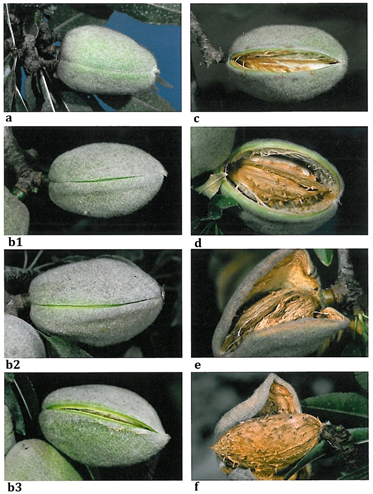The start of shaking almond trees will soon begin in California, as well as the rest of the northern hemisphere. This process utilizes a piece of equipment which clamps to the tree and applies a vibrational force. This energy is transferred to the nut. The vibration moves the nut, which causes the tissues to disconnect at the abscission layer. Nuts then fall to the ground to finish the drying process.

As the nut matures, a few physiological changes occur. Maximum nut weight for ‘Nonpareil’ occurs sometime around the first week of August. Prior to this point, kernel weight is accumulating as the sugars are turning into fats and proteins within the kernel. This conversion is what gives the kernel weight after drying. As this is happening, the abscission layer forms between the nut and the peduncle (also known as the separation zone). As the nut continues to mature, moisture within the hull will decrease and the abscission layer will become more apparent.
Generally, nuts become easier to shake as they mature, but this isn’t always the case. Increased fertility and irrigation rates have increased the variability of ripening. Also, certain varieties (‘Independence,’ ‘Padre,’ ‘Wood Colony,’ ‘Price’ and ‘Monterey’ to name a few) are difficult to shake due to the incomplete formation of the abscission layer or the structure of the tree’s canopy. Diseases or toxicities (e.g. Hullrot and boron toxicity) may also make it difficult to remove nuts as gumming may cause the nuts to stick to the tree. Lastly, hull-tights, or nuts in which the hull has completely dried may not be easily removed due to the lack of weight during the shaking process. These factors will increase the mummy counts within the trees, requiring poling or a second harvest, or a more effective sanitation program.
Due to these factors, an earlier harvest should be considered. This shake-timing should occur after the completion of kernel weight accumulation but before the hull completely dries. The moisture within the hull can help with nut removal as the increased mass can lead to an easier separation. Shaking earlier will require a longer period of drying on the ground.
Ideally, shaking should begin when 100% of the nuts have are 1/2 to 2/3rds of the way split and the hull is still green (stage d, figure 1). This is the point of maximum weight accumulation. However, many farmers have found that beginning to harvest slightly earlier provides a cleaner shake, which removes more nuts and reduces harvesting expenses, leading to a greater yield and more income. This timing is when all the nuts have reached an opening of 1/4-1/2” (8-12 mm) (stage c, figure 1). The first-to-open nuts will probably be fully open and dried.
Wanting to shake earlier will require a bit more work. Prior to the start, test shakes should occur across the orchard after nuts hit the targeted stage. When shaking removes 99% of the nuts from the test trees, begin the harvesting process. Test trees should represent both the greener and drier areas of the orchard. If bark damage is observed, stop shaking and wait a couple of days before resuming the process.
Harvesting early has several trade-offs. Navel Orangeworm damage will be less since moths prefer to lay eggs on split nuts in the tree. Generally, sanitation requirements will be less due to better nut removal. Hull-rot will be less since the infected hull will translocate less acid into the tree. On the other hand, a longer dry time will also lead to a greater exposure for ant feeding/damage. Irrigation management is more challenging due to nuts being spread across the orchard floor for a longer period of time (A single sweep pass could be useful to remove nuts from the drip-lines). Foreign material may be higher due to the increase of hull dry-down on the orchard floor. Finally, and most importantly, bark damage may be increased since bark strength increases through the month of August and September.
The timing of shaking trees at harvest depends on a variety of factors. When timed correctly, it will lead to an increase in nut removal and smoother farm operations. The earliest harvest should start when 100% of the nuts split a 1/4-1/2″. At this timing, some nuts will be fully split, while others will still have moisture in the hull. The added weight from the hulls helps with removal. Starting early has trade-offs which should be considered for the farm operation. Finally, remember to conduct test shakes prior to determine the percentage of nut removal and bark damage occurrence, and if needed, delay shaking by a few days.


Frank
December 13, 2019What should I consider before winter shaking my almonds and what is the timing window?
Thank you
David Doll
December 14, 2019Frank,
Feel free to start once the trees drop enough leaves so mummy counts can be made. As long as the equipment doesn’t leave ruts in the field, shaking can commence. As far as how late you can start shaking the trees, please see this article: https://thealmonddoctor.com/2018/01/19/shaking-almonds-winter-sanitation/
David